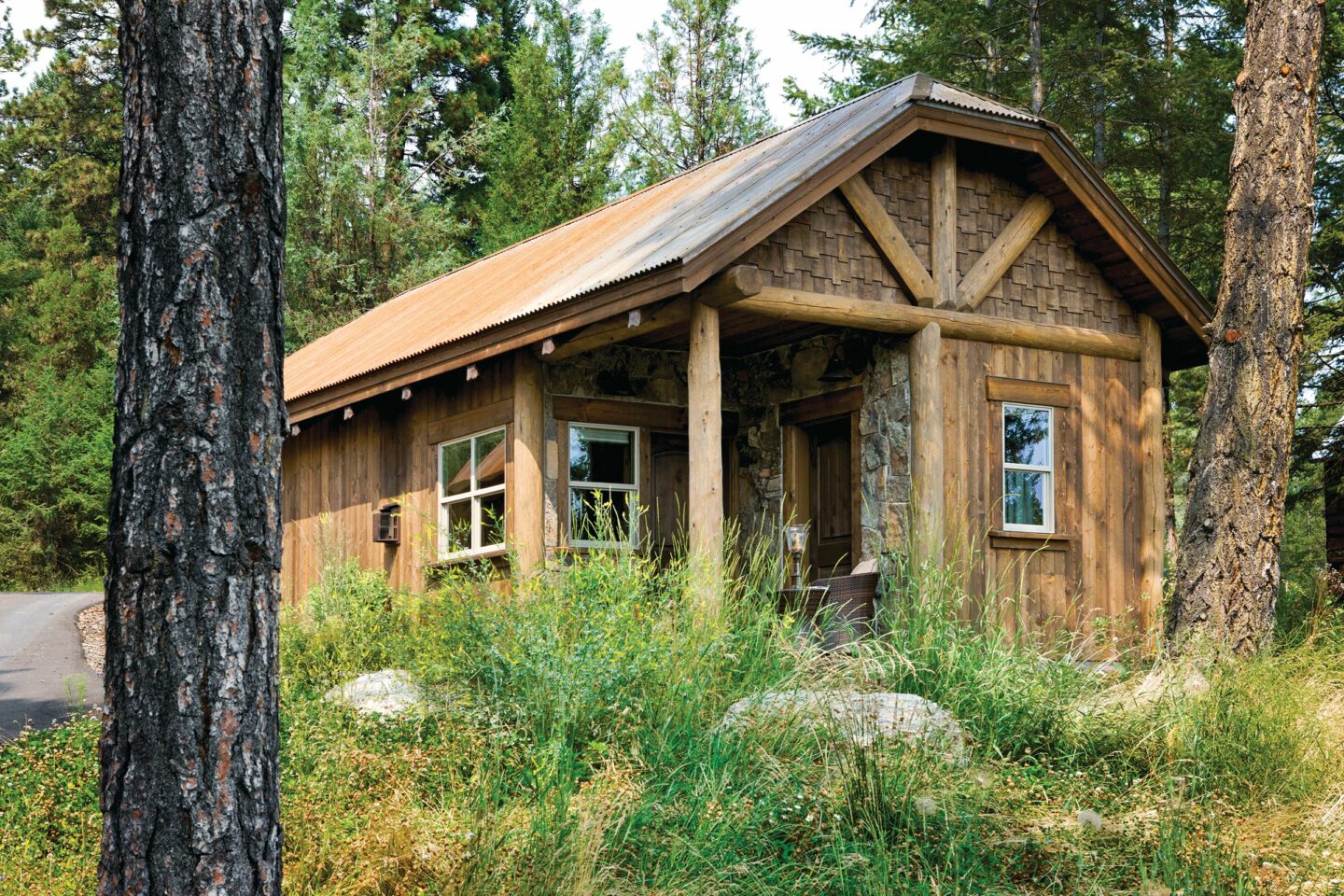How to find a lender to buy and build your dream home.
If you haven’t applied for a mortgage loan recently, say in the last 13 years, then you will likely be in for some surprises when building your new log and timber frame home. That’s because the lending space for housing has changed dramatically.
It all started way back in 2010 when the Dodd-Frank financial reform law was signed by President Obama. The loose lending practices of the early 2000s led to the housing market meltdown in 2008, and the Great Recession, as well as nearly eight million foreclosures in the U.S.
The new rules that came with Dodd-Frank cost lenders millions in labor and new software to achieve compliance. The law also inadvertently changed the lending market.
The big four nationwide banks largely abandoned the mortgage market after 2008, leaving it to regional banks, savings and loans, and credit unions. Moreover, most mortgages now originate from nonbanks. Nonbank mortgages went from 10% of the market in 2009 to 68% in 2020, according to the industry research firm Inside Mortgage Finance. These lenders don’t take deposits or offer other banking services. But what they do offer is nimble online applications that can reduce loan approval times.

Much More Documentation
Dodd-Frank made the application process much more rigorous. When you reach out to lenders for a loan to buy land, or a construction loan, or a final mortgage, you will have to fill out much more documentation than in years past. This documentation of employment and debt levels will also include information on your retirement accounts and all equity, proving you can repay the loan.
The biggest misconception in the new lending era is that borrowers need a large downpayment to buy and build a house. It’s not necessarily more difficult to qualify for a loan, but it does require much more documentation, lenders say.
Borrowers complain that it’s not just the increase in documentation that’s required, but the level of creditworthiness that is making it difficult to buy a new home. Mortgage rates, at their highest level in 20 years, are further affecting home buyers.
Private sectors investors have not returned to the mortgage market. Loans backed by the government entities Fannie Mae, Freddie Mac, and the FHA are now 90 percent of all of new mortgage loans—a historically unprecedented rate. During the housing boom, they were barely a third of the market.
The mortgage loans being made now are only the best of the best borrowers. The credit scores on loans today are the highest in history. As a result, foreclosures are at historically low rates as well.
Most log and timber frame home buyers finance their purchase. The tax benefits alone make getting a mortgage attractive. This is true even for those few who can pay cash to buy and build. However, even though interest rates are high, there are still ways to get a loan at a lower rate than prime.
Digging Into Details
When it comes to your individual financing program, you will have your choice from a vast array of options. But they basically boil down to two kinds: fixed rate and adjustable. To choose which one is best for you, you will need to analyze your priorities. Do you need a mortgage interest deduction on your taxes? Will this home be a permanent residence or a vacation home? Is your goal to pay it off quickly or over the long term? Your answers and advice from a financial advisor can help you sort out the best program.
Dodd-Frank created the Know Before You Owe mortgage initiative. This is based on TRID, or the TILA-RESPA Integrated Disclosure rule. Additionally, a new single Loan Estimate form, or “LE,” and the HUD-1 Settlement Statement was replaced by the Closing Disclosure, or “CD.”
These new rules mean the clock is ticking (for the lender) once you submit your loan application. Home buyers applying for a loan today receive their Loan Estimate or LE from their lender three business days after a lender receives your loan application. Additionally, your Closing Disclosure or CD from your lender arrives three days prior to closing, so you have time to review it thoroughly before signing any documents at the closing.
The intent behind these regulations is not to cause you undue stress or delays—it’s to make it easier for home buyers to understand the terms and streamline the loan application process by placing all the relevant details in one document. In addition, the LE and the CD look very similar so you can better compare your actual charges in the Closing Disclosure to the estimated charges in the Loan Estimate when you applied for the loan. These guidelines are in place to protect you from mistakes or other factors that could cause you to default on the loan, placing both you and your lender at risk.
Documentation
What financial information will you need to gather to go lender shopping? Here’s what lenders say you will need to help you qualify for a loan:
- A 700+ credit score is usually required
- Two years of W2, 1099 and full 1040 (federal, not state) forms, both personal and business, plus K-1 form (if applicable
- Thirty days of paystubs or monthly pension advisements
- Your Social Security or pension award letter
- Two months of complete bank statements for accounts, including savings, checking, stocks, etc.—every page, not just the summary
- Your most recent quarterly 401k statement and/or other retirement accounts
- A letter of explanation on any negative credit (if applicable)
- A mortgage statement for your current home and any additional properties you own
- An estimated contract for your new log and timber home plan to justify the amount you want to borrow
- A contract for the land on which you intend to build
- A 20% down payment for conservative lenders; others will allow as low as five or ten percent
With this information, lenders will look at your income-to-debt ratio, any large or unusual deposits, as per The Patriot Act, and your work history to help them determine your ability to repay the loan. Ratios can fluctuate between lenders. Most lenders will allow a 40 percent total Debt to Income ratio for purposes of a Qualified Mortgage. Some lenders can also offer non-Qualified Mortgages (debt-to-income over 43%) with compensating factors such as high reserves or a high amount of discretionary income.

Besides your financial status, lenders will want to know exactly what you’re going to build, how much it will cost, how long it will take and who’ll be doing the work. This will help the lender estimate the home’s potential value and determine how much the lender will lend. Here’s some information you’re likely to provide to obtain a loan.
- Building permits: Construction documents that comply with local building codes will have to be presented to the local permitting office for approval before you can obtain a building permit.
- Sales contract for the log and timber home package: This should include a complete bill of materials that your log and timber home producer will supply.
- Plans and specifications: A floor plan in a producer’s catalog isn’t enough. Lenders will want to see construction drawings, detailed material specifications and descriptions of building materials. These documents will tell the lender exactly what is being financed and help the loan officer assess its value.
- Cost estimates: You’ll need copies of written bids and estimates to determine a detailed cost estimate.
- Builder contract: If you are hiring a general contractor to build your home, you must have a copy of the agreement showing costs and specifications. Most lenders prefer to approve a loan if a professional is handling construction.
- Statement of your construction abilities: If you do intend doing some or all the work yourself, supply the lender with information on your qualifications, such as photos of projects you’ve completed or other evidence that you’re capable of completing the construction of your log and timber home. The more you can reduce risk to the lenders, the better your chances of getting approved.
- Survey or plot plan: This plan shows the exact location of your land and provides a legal description of the property.
- Land deed: This document shows the title and mortgage information on the property where you intend to build.
- Information on the log and timber home producer: Your contract explaining what the log and timber home company will be providing, including a materials list and a copy of the company’s construction manual.
Most buyers build their dream home by having two loans: a construction loan and a mortgage or the combination of a construction-permanent loan. The advantage with the latter is one closing cost. Once the home is constructed, the loan is automatically rolled into a typical mortgage payment.
Appraisals and comparables can be another sticking point in financing. To help your situation, start by informing your appraiser that log and timber homes need not be compared to other log and timber homes. They should be compared to other custom homes recently sold, as per the Fannie Mae FAQ on appraisal property report. Refer the appraiser to questions 25 and 26, which have been recently updated: https://www.fanniemae.com/content/faq/appraisal-property-report-faqs.pdf
Q25. UPDATED Are loans secured by unique or non-traditional homes eligible for delivery to Fannie Mae? Yes. Fannie Mae does purchase loans secured by unique or non-traditional housing types, such as, but not limited to, “tiny” homes or “container” homes, log homes, earth berm homes, and geodesic domes, which can be in all areas, including rural locations. Loans on these types of properties are eligible for delivery to Fannie Mae provided the appraiser has adequate information to develop a reliable opinion of market value and the property meets other eligibility requirements.
Q26. UPDATED Is there a required number of comparables that must be of similar design or appeal as the unique or non-traditional home that is being appraised? No. There is no requirement that one or more of the comparables be of the same design and appeal as the property that is being appraised. However, appraisal credibility is enhanced by comparables that are the most similar in design and appeal.
Another resource is the free “Appraising Log Homes” white paper by the National Association of Home Builders (NAHB). Go to www.nahb.org and type in How To Appraise Log and Timber Homes.
You may have to provide more information than homeowners did a decade ago to obtain your mortgage but once it’s approved you’re well on your way to living in your dream home.

